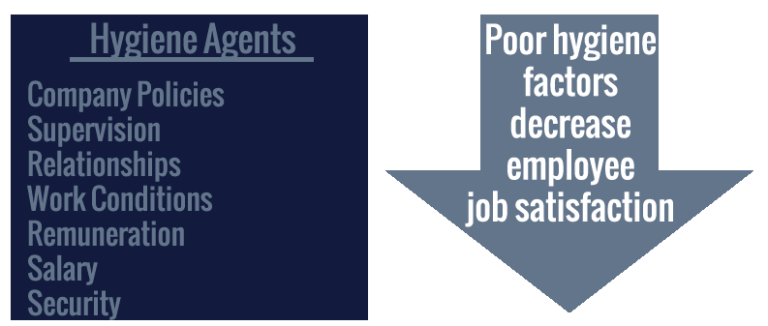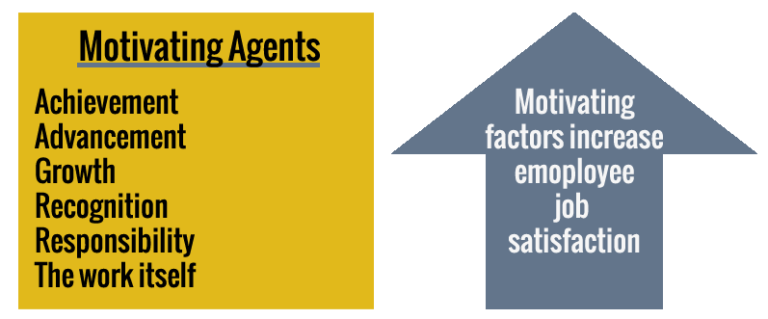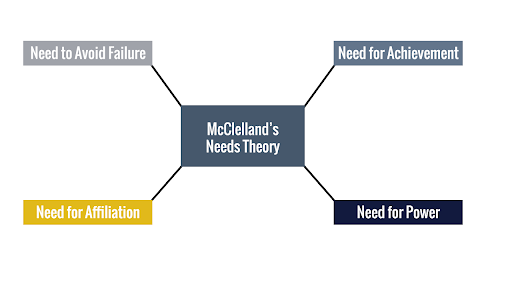Getting Radical Results with Reinforcement Theory
Shoulders slumped, half closed eyes, slow robotic movements and one word answers. These are some of the most obvious signs your team has lost their motivation and it’s a call to arms for any Leader that cares about their people. If you’re here, then there’s a good chance that you care about your team, their performance and want to create a culture that’s full of contagious inspiration and motivational drive. Whilst all people and teams go through dips in motivation, it’s important to understand some of the key contributing factors so we can put our teams in the best position to feel motivated and engaged, which in turn will improve performance and feelings of fulfilment.
In this article we are going to look at what Behavioural Reinforcement theory is and explore 2 models that cover it: Herzberg’s Two Factor theory and McClelland’s Needs Theory. We are going to challenge ourselves with questions and consider how we can utilise these theories to bring the spark back in our teams.
What is Behaviour Reinforcement Theory?

Behaviour Reinforcement theory looks at how people respond to both positive and negative feedback. It also looks at the correlation of employee behaviour with what they think the outcome of their actions will be. In short, its cause and effect, for example:
- If you achieve your targets, you get recognition.
- If you complete more than the allocated workload, you are massively helping the team.
- If you act in a way that is considered gross misconduct, you will be fired.
Reflective question: Think back to a time where someone shouted at you or chastised you for something you did or said. How did that make you feel?
Reflective question: Did it make you want to avoid getting that reaction again? Did that change your behaviour or action?
Reflective question: Now let’s turn that question around a bit…Think back to a time when someone celebrated an action or outcome you achieved, how did that make you feel?
Reflective question: Further to this, did it make you want to do the same or similar again?
With this in mind, we can understand how feedback can reinforce the right behaviour. If you think about when you have been recognised for an achievement and how that made you feel, it is soon clear how this may work. Positive reinforcement encourages a repeat of the previous behaviour as we find the reward motivating. In fact, in a recent CIPD paper ‘employee recognition and non-financial rewards ‘, they found that positively recognising an achievement encouraged performance and engagement…they also found that generic recognition vs specific, achievement based recognition decreased motivation, performance and engagement. So whilst recognition is definitely a tool to use, if you’re recognising your people, do it for the right reasons, for the right behaviours and for key accomplishments.
Alongside this, if you embed an environment of reciprocity, your positively reinforced team will begin to positively reinforce each other as well, increasing the motivational climate. Encourage your team to celebrate hard won victories but just as important, if someone fails – acknowledge and thank them for their hard work and attempts before working with them on improvements.
Feedback isn’t always positive though and we all know that some people can take constructive feedback poorly no matter how it is positioned. Depending on whether the person you are feeding back to has a Growth mind-set or a Fixed mind-set will wildly influence how they take on board your feedback…so do we need to consider upskilling our team’s mind-set?
Whether giving positive or constructive feedback, the way you implement this to create a motivational climate is to always be open and honest. Ensure you include these in your values and live by them. When people know that all feedback comes from the place of support, development and growth, they will be more open to improving their skill sets and less likely to push back against it.
Now we know what Behaviour Reinforcement is, let’s discover two theories that can help us harness the power of motivation to drive our teams to victory.
Herzberg’s Two Factor Theory
Herzberg’s theory looks at what motivates people to perform and splits these into two factors, Motivating agents and Hygiene agents. Hygiene agents are what people expect as a standard, they don’t improve morale or motivation but a lack of their presence leads to a decrease in job satisfaction. If you are missing any of these, fix this issue instead of throwing Motivating agents at your team.

Looking at the Hygiene agents, relationships and supervision really highlight the importance of feedback within a motivational climate. Without the correct supervision, employees may become disengaged with their work as they are not receiving any guidance. Relationships come in all shapes and sizes but fostering an open and honest environment will help people feel secure and build trust, making it an essential factor for a motivating climate.
When we look at company policies and supervision, we don’t mean that you should micromanage or remove any independence (that’s a superb way to disengage people) – what we mean is understand what levels of support and autonomy each member of the team needs and ensure they have it. Both Servant Leadership and Situational Leadership can give you great insights into different styles of leadership you can use to support your people.

Looking at Herzberg’s Motivating Agents, we can see that achievement, advancement, growth and recognition all lead to an increased job satisfaction. All of these can be the basis of feedback, which highlights how important it is towards fostering a motivational climate.
Reflective question: How are you setting your team up to achieve?
Reflective question: How many Hygiene and Motivating Agents are you fostering?
One important factor that we can see from Herzberg’s Hygiene agents is that salary is not a motivating agent, indicating that financial gain is not enough to develop a climate of motivation. Whilst some people will be driven financially, this should help employers understand that high wages and bonuses on their own are not enough to encourage top performance. As a Leader, you can therefore focus on the motivating agents, which all focus on self-actualisation and achievement.
Now that we have discovered Herzberg’s Two Factors, we can explore McClelland’s view.
McClelland’s Needs Theory
McClelland created his Needs Theory, which looks at a person’s needs as the root cause of their behaviour. He broke motivation down into four main needs; achievement, power, affiliation and avoiding failure. It is time to explore these needs further.

The need for achievement
The need for achievement focuses on a person’s desire to accomplish. We are driven by that sense of achievement, like an adrenaline rush it drives us to achieve again and again. We see this with sporting personalities, often when they achieve, they push themselves to keep achieving and when they retire they often say there is no feeling like it and unless they have a new purpose or goal to focus on, their behaviour can become self-destructive. The best way to nurture this need is to set stretching goals, which will challenge your follower and increase their sense of achievement when they accomplish their goal.
Reflective question: What stretching goals are you setting with your team?
Reflective question: How do your team know when they have achieved their goal?
The need for Power
The need for power looks at how people need to feel respected and authoritative. People with this need want to control and influence others, enjoys status and recognition, wants to win arguments and likes competition (and of course winning).
Reflective question: How could you use the need for Power to motivate people without excluding others?
When not kept in check, this need can become toxic and destructive for the team so be mindful of creating an inclusive environment and using multiple criteria for success – this enables people to achieve in an area that plays to their strengths.
For example, could you run an incentive that included all of the below:
- Productivity
- Quality of work
- Impact on long-term objectives
- Team work
One key question to consider when planning an incentive is “what behaviours and values do I want to drive?”
Reflective question: How do your team know their power, influence and status?
A quick lesson can be taken from Jocko Willink, a navy S.E.A.L that was in charge of team Bravo. He renamed them Team Bruiser. This helped the team understand that even though there was a Team Alpha, Team Bruiser were second to no-one. The team rallied behind this identity, it became a symbol of pride, power and influence.
Reflective question: What can your team be known for that they do better than anyone else?
The need for affiliation
The need for affiliation is to be accepted by others and your wider group. Most people want to fit in, at least on a subconscious level. We are drawn to people that are like us and that identify as we do. In general, we adopt the mind-set, values and behaviours of the group we are part of to help us fit in and feel part of something larger than ourselves.
Reflective question: Have you ever felt the drive to be accepted by a person or a group of people?
Reflective question: Have you ever felt rejected or like you didn’t belong?
Reflective question: What strategies could you utilise to create positive values and behaviours?
You can typically motivate people with a need for affiliation by encouraging a team mind-set to your organisation, encouraging big picture thinking and facilitating a team charter, where the group decide on an setting norms, values, beliefs and expectations that lead to positive results. If the team are aligned in this vision and helped create it, simply reminding people of the charter can be enough to motivate the desired behaviours.
The need to avoid failure
The need to avoid failure was added later and is a major motivator. People are often afraid to try because they feel they will fail. We now often call this a ‘Fixed mind-set” and you will hear people with one say things like:
- “I can’t do it!”
- “I’m too old to start!”
- “That just isn’t me!”
A simple and powerful method for reframing moat of these limiting beliefs is to add “yet” to the end of them or simply repeat the statement as a question: “You’re too old to start?”
At the end of the day, when a person has a fixed mind-set, we need to understand that it’s their ego that is holding them back, the fear of failure and ridicule is stopping them from growing.
It is the leader’s job to encourage trying new methods and embracing failure as a chance to learn and hone skills.
Jeff Weigh, author and facilitator once explained the ‘IF, THEN…’ mind-set at a workshop I attended. Quite simply, tell the fear voice “if that happens…then I will”
For example, if the fear voice is saying people will laugh at your presentation, simply state: “if people laugh at my presentation, then I will…”
This mindset focuses on solutions instead of catastrophizing the event. Simple solutions could be:
- “Then I will make a joke about the presentation myself and then Refocus on why what I’m saying is important.”
- “I will pretend I can’t hear them and carry on.”
- “I will deliver my presentation and ask for feedback.”
As a leader it is your responsibility to understand you team, their values and their needs in order to understand their motivators. By doing this, we can work to link their values with the organisations values and therefore their work. Where possible, let people see the impact of their work on the wider objective, and celebrate what their hard work means.
Conclusion

Motivation is a state that comes and goes in most individuals and teams. When people feel motivated, they are more engaged, more productive and find it easier to be fulfilled by their tasks.
Behaviour reinforcement theory uses cause and effect or consequences to shape a person’s behaviour. You can positively reinforce ideal behaviour and add consequences to inappropriate or insufficient behaviour. Be mindful in how you lead like this and ask yourself what is appropriate for: the team, the business and the customers. Remove how you feel out of the equation otherwise you may be more likely to react with your ego where a more supportive style would have been better.
Herzberg’s 2 factor theory identified 2 types of drivers for people; Hygiene agents and Motivating agents. People are not motivated by Hygiene agents but expect them to be there. If they are not present, Motivation will decline. Hygiene agents are; policies, supervision, relationships, work conditions, remuneration, salary and security.
Motivating agents are; Achievement, advancement, growth, recognition, responsibility and the work itself. If you focus on these motivators and cater then to each individual needs, you will begin to see motivation levels increase.
McClelland’s Needs Theory looks at 4 human needs that can be used to motivate, whether that’s reinforcing positive behaviour or adding consequences to unacceptable behaviours. The human needs are; Achievement, Power, Affiliation and Avoid failure.
Want to test your knowledge?
We’ve prepared some questions for you below that will help you to embed the information and apply it in different situations.
- In your own words, what is Behaviour Reinforcement theory?
- List the Hygiene agents
- Explain how a person’s motivation level may be impacted by each of the Hygiene agents
- How could you ensure the Hygiene agents are present?
- List the Motivating agents
- Discuss and write down situations where you could utilise each of the Motivating agents
- List the 4 Needs according to McClelland
- Discuss how you could use each of the 4 needs to positively reinforce the ideal behaviours
- Discuss how you could use the 4 needs as a consequence for inappropriate or inadequate behaviour.
This Blog was written by Simon Tickner from Develop the Edge
Our Apprenticeships
Contact Us
Stay Up To Date
Our Training Courses